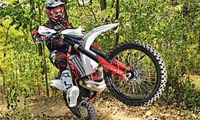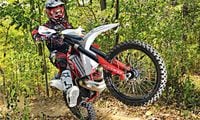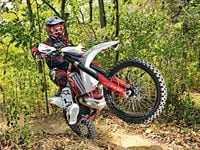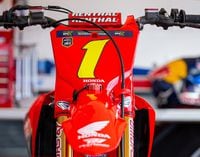Much like the Spanish explorer-soldiers of old, Gas Gas is carrying out an invasion on American soil. Armed with a new U.S. importer, a revised model lineup and a growing complement of loyal dealers, the Spanish manufacturer's assault has already begun. Led by the freshly formed Gas Gas Offroad US distributorship, new bikes are flowing into the hands of excited customers everywhere, with better support in place to maintain the charge. Dirt Rider was recently invited to test one of the first 2011 Gas Gas XC 250s to enter the country at the Muddobber National Enduro in Indiana. The weather ranged from dry and hot on our setup day to cold and muddy on race day-a perfect range of conditions in which to evaluate the foot soldier of Gas Gas' army.It had been a number of years since I'd spent any significant amount of time on a Gas Gas, and during our initial day of testing I was pleasantly surprised to find that the bike had evolved considerably since I last rode one. Even when compared to the 2010 model, the new machine boasts several improvements including revised suspension, better cooling (by way of a thermostat and new radiator cap, and now without the coolant catch tank on the headset), an updated front headlight and an FMF Q-Stealth silencer, which is an amazing stock feature in itself. The choke is now mounted on the handlebar for easy access via a small "cold-start" lever. Before heading to the starting line of the enduro, my race bike was outfitted with Enduro Engineering hand guards, Michelin tires with foam inserts and a 5mm-shorter brake pedal adjuster bolt to allow for a lower setup. In stock trim, the XC 250 is a sharp-looking motorcycle, and with these minor mods in place it looked completely ready to go to war.Available in both kick- and electric-start models (I ran the kick), the XC 250's engine is incredibly potent and usable. The delivery starts out with a smooth, crisp hit that steadily ramps up into the midrange. Then, a strong surge of power kicks in via the VForce3 reed valve and carries the revs into the top-end, which eventually winds out without falling off too hard or vibrating excessively. For a stock 250cc two-stroke, the Gas Gas runs very cleanly and didn't require any departure from the stock carburetor settings. However, I did go up two teeth on the rear sprocket to keep the bike from feeling bogged down in between gears on the tight Indiana terrain. The XC 250 comes with a 48-tooth rear, and I think a 49 would be sufficient for most settings outside of narrow trails. The six-speed transmission is smooth and evenly spaced. In dry dirt, the front end of the Gas Gas would easily come up without the use of the clutch, and I found myself riding just on the crest of the midrange surge, as this made it easiest to modulate the power and carry speed through turns. Whacking the throttle open hard would either cause the motorcycle to break loose or almost loop out, effects that were not ideal but were easily avoided nonetheless.
The XC 250 may be an off-roader, but the company's trials-based heritage has not been lost on this Gas Gas. The front end retains a lightweight feel that makes foot-plant turns and abrupt weight changes a breeze. The bike turns well without exaggerated corner entry on the part of the rider, and it will drop into a tighter line and stay in a rut without complaint. Low-speed front wheel placement is extremely precise, meaning that if you spot a stump at the last minute, you can get around it with room to spare, with the rear wheel following suit. The exception to this precision was in fast, flat turns where the rear of the bike would push to the outside of the corner. This isn't so much a loss of traction as it is a handling trait, and it occurred predictably in dry terrain. The ergos of the XC allowed me to get way up on the tank in turns, and the handlebar had a comfortable sweep to it, though the seat feels flat and rigid after a long day. On the bike stand, the steering stop felt as though it contacted the frame way too early, but I never noticed this on the trail.
The suspension on the XC 250 that I rode wasn't completely in line with what the production bikes are being sold with, but it still gave me a glimpse of Gas Gas' target off-road setup. With 155 pounds of editor on board, both the fork and the shock were a little too busy for my taste and greatly benefited from going three clicks slower on the rebound on both ends. I set the shock sag at 113mm and was able to tune out an initially harsh feel by softening the high-speed compression. At first, the shock was too firm in the top of the stroke and was standing me up in corners, but with these changes in place the bike remained settled and still had decent bottoming resistance. The Indiana terrain had a lot of exposed roots that deflected my mount's front tire, but much of this feel was due to the foam inserts that actually allowed me to slam into square edges and abrupt obstacles faster. Overall, the suspension character was hugely improved from what I remember of Gas Gas.On race day, the Indiana hardpack was transformed into a mixture of loam and snot. I was placed back on the 61st row surrounded by a rowdy crowd of fun-loving enduro junkies who were an absolute hoot to ride with. Right off the start, the changing conditions forced me to ride the Gas Gas in a lower rpm range, where I quickly gained an appreciation for the bike's torque and flywheel lug, both of which were flawless for the rugged terrain. The 18-inch rear tire stayed fairly well hooked up considering the conditions, and the 50-tooth rear sprocket was perfect for the course. Neutral was a little too easy to find for my liking, as I accidentally clicked it three or four times throughout the day, but I dug the six-speed tranny on transfer sections.In one such asphalt transfer section, I lost the front end in third gear and hit the deck sliding. Luckily, my elbow and hip broke my fall (that tickled...not), and after retrieving the bike from down the road I found it scraped but otherwise unharmed. In the next special test, a tight and log-strewn route through dense trees, I discovered that the Gas Gas is extremely resistant to boiling over. There was one hilly bottleneck in particular where all of the orange bikes around me were blowing steam, but the XC 250 stayed at a reasonable temp. This, combined with the obvious quality of the components and the bike's performance in harsh conditions, gave me full confidence in the Gas Gas' durability. I'd take this two-stroke back to Romaniacs with me in a heartbeat.
Without a doubt, the highlight of my ride came in the form of a nasty, wet, uphill log section surrounded by amused locals. After becoming slightly high-centered on one of the last logs, I watched one of the enthusiastic locals jump down the hill to give me a hand. Before grabbing hold of one of the muddy fork legs, the man narrowed his gaze, looked me in the eye and said in a thick Midwestern accent, "I'd better read about this in ya'll's magazine!" There you go, buddy, and thanks again for the hand!
When all was said and done, I ended up with a top-17 finish in the 250A class (translation: I got 17th) and had a great time aboard the Gas Gas. I didn't go into the race with any major expectations for the bike, but I certainly came away from it impressed with both the performance and the durability of this machine. Is it competitive with other off-road two-strokes of equal displacement? Absolutely, and given the nasty conditions of the race I would not have chosen to race a four-stroke over the XC 250. Gas Gas is on to something with this machine, and I predict that recent changes within the U.S. branch of the company will only help the bikes' popularity and accessibility among trail riders and enduro racers, many of whom are awaiting the Gas Gas invasion with open arms.
MSRP: $7,599; electric-start $7,899
Claimed dry weight: 223 lb
Fuel capacity: 2.5 gal.
Contact: www.ggor.us





/cloudfront-us-east-1.images.arcpublishing.com/octane/OFSXJJ5PZFEZ5D5ZPMCFVHJUMA.jpg)
/cloudfront-us-east-1.images.arcpublishing.com/octane/N2JLNLG44VEKBMEPORRDTMX5A4.jpg)
/cloudfront-us-east-1.images.arcpublishing.com/octane/EOERU244ONEWVKQ7C24OHMRVWY.jpg)
/cloudfront-us-east-1.images.arcpublishing.com/octane/JF4T3ULTGNHTVEKSTNKLJ2IGKY.jpg)

/cloudfront-us-east-1.images.arcpublishing.com/octane/FAOZEEEXFVA3ZK2PYMY3DHI2EQ.jpg)
/cloudfront-us-east-1.images.arcpublishing.com/octane/WCAUGYKA5FDZTB64FM36LJFMMM.jpg)
/cloudfront-us-east-1.images.arcpublishing.com/octane/EIDVOIN5IJDMRIVS2VNTOOBVSA.jpg)
/cloudfront-us-east-1.images.arcpublishing.com/octane/5BSWCTPONFB3DJFRPJ34STZMR4.jpg)
/cloudfront-us-east-1.images.arcpublishing.com/octane/KSERUHQUTNHLBCWKXS2R3TYZHI.jpg)
/cloudfront-us-east-1.images.arcpublishing.com/octane/GGOH2AQRSVHY5C5JLNEVYLB5SU.jpg)
/cloudfront-us-east-1.images.arcpublishing.com/octane/TJJEHV3ATZFFXHUYZABHXKE2DI.jpg)
/cloudfront-us-east-1.images.arcpublishing.com/octane/M7L5LNQ5JZENHNBTCHEIKZKD24.jpg)
/cloudfront-us-east-1.images.arcpublishing.com/octane/WIC4RXQ36BAXNIW6U4UJ3XDLKI.jpg)
/cloudfront-us-east-1.images.arcpublishing.com/octane/G64JLSXQBJFMVPTETPM4H353EU.jpg)
/cloudfront-us-east-1.images.arcpublishing.com/octane/ZBMLCCOSNJBIVAEC2OU6YSONKY.jpg)
/cloudfront-us-east-1.images.arcpublishing.com/octane/U7PDRXGEI5DCFJGSVGNLAHGIMA.jpg)
/cloudfront-us-east-1.images.arcpublishing.com/octane/S553MV5QAJFOHGOKYO7TJ6NGYA.jpg)
/cloudfront-us-east-1.images.arcpublishing.com/octane/62WLA7IMLVF2LIPTA4DGILHZIM.jpg)
/cloudfront-us-east-1.images.arcpublishing.com/octane/BW6RDLNDENAVFHMPINCIIY3XCI.jpg)
/cloudfront-us-east-1.images.arcpublishing.com/octane/FEROGJTVONBBZKEUH46OD6R2VY.jpg)
/cloudfront-us-east-1.images.arcpublishing.com/octane/IFBSQJ2HCFG5JKH4GM3NB5LC3M.jpg)
/cloudfront-us-east-1.images.arcpublishing.com/octane/GPNWD73XDJDG7LMXDVFDZ7CL2I.jpg)
/cloudfront-us-east-1.images.arcpublishing.com/octane/BDI3FSQXIFAYHNC62TCPI3DV7E.jpg)